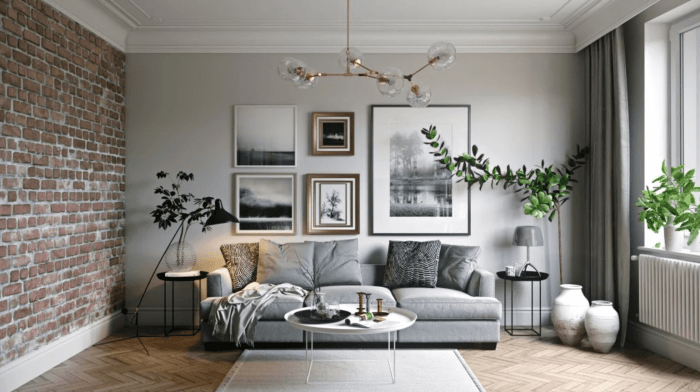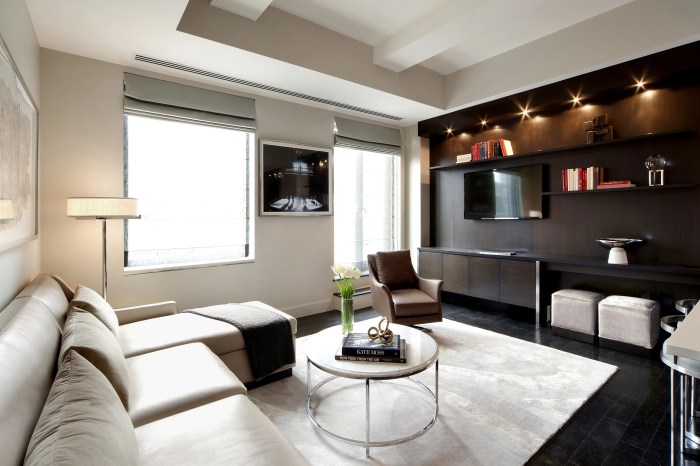Exploring the World of Interior Design

Delving into interior design, this introduction immerses readers in a unique and compelling narrative. Interior design is a multifaceted field that involves creating aesthetically pleasing and functional spaces, blending creativity with practicality. From the harmony of colors to the arrangement of furniture, every detail plays a crucial role in shaping the atmosphere of a room.
Join us on a journey through the art and science of interior design.
Interior design is more than just selecting paint colors or furniture; it's about transforming spaces into reflections of personal style and purpose. As we delve deeper into the intricacies of interior design, we uncover the magic that turns a house into a home.
Introduction to Interior Design
Interior design involves creating functional and aesthetically pleasing spaces by carefully planning and arranging furniture, colors, textures, and decor elements.
Interior design plays a crucial role in enhancing the functionality, mood, and overall appeal of a space. Well-designed interiors can improve productivity in work environments, create a relaxing atmosphere in homes, and enhance the overall experience in commercial establishments.
Examples of Well-Designed Interiors
- The Apple Store: Known for its minimalist design, the Apple Store's interior layout and use of materials create a sleek and modern atmosphere that complements the brand's image.
- The Four Seasons Hotel: With its luxurious furnishings, elegant color schemes, and attention to detail, the Four Seasons Hotel creates a sophisticated and inviting ambiance for guests.
- The Google Headquarters: Designed with a focus on employee well-being and creativity, Google's office spaces feature open layouts, vibrant colors, and unique recreational areas to foster innovation and collaboration.
Elements of Interior Design
Interior design involves a combination of various elements that work together to create a harmonious and visually appealing space. Each element plays a crucial role in shaping the overall look and feel of a room.
Colors
Colors are one of the most powerful tools in interior design. Different colors can evoke different emotions and set the tone for a space. For example, warm colors like red, orange, and yellow can create a cozy and inviting atmosphere, while cool colors like blue and green can promote calmness and relaxation.
It's essential to consider the purpose of the room and the desired mood when selecting colors for a space.
Lighting
Lighting is another vital element in interior design as it can significantly impact the ambiance of a room. Proper lighting can enhance the overall aesthetic appeal of a space, highlight architectural features, and create a sense of warmth and comfort.
Different types of lighting, such as ambient, task, and accent lighting, serve various functions and can be used to create different effects in a room.
Interior Design Styles

Interior design styles encompass a wide range of aesthetics and approaches to creating beautiful and functional spaces. From the sleek lines of modern design to the ornate details of traditional design, each style has its unique characteristics and appeal.
Modern Interior Design
Modern interior design is known for its clean lines, minimalism, and emphasis on open spaces. Neutral colors, sleek furniture, and a focus on functionality are key elements of modern design. Some famous modern interior designers include Le Corbusier and Ludwig Mies van der Rohe, known for their innovative and influential designs.
Traditional Interior Design
Traditional interior design is characterized by rich colors, ornate details, and classic furniture pieces. This style often draws inspiration from historical periods such as the Victorian era or the Renaissance. Designers like Dorothy Draper and Albert Hadley are renowned for their timeless and elegant traditional designs.
Minimalist Interior Design
Minimalist interior design is all about simplicity, functionality, and a focus on essential elements. Neutral colors, clean lines, and clutter-free spaces define this style. Famous minimalist designers like John Pawson and Tadao Ando are known for their serene and uncluttered interiors that exude a sense of calm and tranquility.
Space Planning
In interior design, space planning is the process of analyzing how a space will be used and then organizing furniture, fixtures, and other elements in a way that promotes functionality and flow.
Importance of Functional Layouts
Functional layouts are crucial in interior spaces as they ensure that the room serves its intended purpose efficiently and effectively. A well-planned layout can enhance productivity, comfort, and overall well-being.
- Consider the purpose of the room: Before arranging furniture, determine how the space will be used to create a layout that supports those activities.
- Maximize natural light: Position furniture and fixtures to take advantage of natural light sources, creating a bright and inviting atmosphere.
- Traffic flow: Ensure there are clear pathways and sufficient space for movement to prevent the room from feeling cramped or cluttered.
- Multifunctional furniture: Opt for pieces that serve more than one purpose, such as storage ottomans or convertible sofas, to maximize space utilization.
Tips for Effective Space Utilization
Effective space utilization is essential for making the most of any room, regardless of size. By following these tips, you can optimize the functionality and aesthetics of your space:
- Declutter regularly: Keep only the essentials and get rid of items that are no longer needed to free up space and maintain a clean, organized environment.
- Use vertical space: Install shelves or tall storage units to utilize vertical space, especially in small rooms where floor space is limited.
- Zoning: Create distinct zones within a room for different activities, such as a workspace, reading nook, or entertainment area, to maximize functionality.
- Scale and proportion: Choose furniture and decor that are proportionate to the size of the room to maintain balance and prevent overcrowding.
Furniture and Accessories
When it comes to interior design, furniture and accessories play a crucial role in shaping the overall look and feel of a space. They not only provide functionality but also contribute to the aesthetic appeal of the room.
Significance of Furniture
Choosing the right furniture is essential for creating a harmonious and balanced interior design. Here are some tips to help you select the perfect pieces for your space:
- Consider the size of the room and the scale of the furniture to ensure a proper fit.
- Take into account the function of the space and choose furniture that serves that purpose.
- Think about the style you want to achieve and select furniture pieces that complement that aesthetic.
- Pay attention to the material, color, and finish of the furniture to ensure it aligns with the overall design concept.
- Don't overcrowd the space with too much furniture, instead opt for pieces that allow for easy movement and flow.
Importance of Accessories
Accessories are like the finishing touches that complete the design of a room. They can add personality, texture, and visual interest to the space. Here's how accessories can enhance the overall design aesthetic:
- Choose accessories that reflect your personal style and add character to the room.
- Use accessories to introduce pops of color or patterns that can liven up the space.
- Layer different textures through accessories like rugs, pillows, and artwork to create depth and dimension.
- Consider the scale of the accessories in relation to the furniture to maintain visual balance.
- Don't be afraid to mix and match different accessories to create a unique and curated look.
Materials and Textures
When it comes to interior design, materials and textures play a crucial role in creating a cohesive and visually appealing space. The choice of materials can significantly impact the overall look and feel of a room, while textures add depth and visual interest to the design.
Types of Materials
- Wood: Wood is a versatile material that adds warmth and character to a space. It can be used for furniture, flooring, and accents, creating a natural and organic feel.
- Metal: Metal finishes such as stainless steel, brass, or copper can add a modern and sleek touch to a room. They are often used for light fixtures, hardware, and decorative elements.
- Stone: Stone materials like marble, granite, or travertine are popular for countertops, flooring, and backsplashes. They bring a sense of luxury and sophistication to a space.
Textures in Interior Design
Textures play a crucial role in adding visual interest and tactile appeal to a room. By combining different textures, you can create a layered and dynamic look that enhances the overall design.
Influence of Materials on Design Outcome
- The choice of materials can set the tone for the style of a room. For example, using reclaimed wood can create a rustic and cozy atmosphere, while sleek metal finishes can give a more contemporary feel.
- Textures can also influence the perceived size of a space. Rough textures can make a room feel cozy and intimate, while smooth textures can create a sense of spaciousness.
- Combining different materials and textures allows for a more visually engaging design that reflects the personality and preferences of the homeowner.
Epilogue

As we conclude our exploration of interior design, we have unraveled the complexities of this creative field. From understanding the importance of color schemes to appreciating the impact of lighting, interior design is a harmonious blend of artistry and functionality.
Let your imagination run wild as you embark on your own interior design journey, shaping spaces that inspire and delight.
FAQ
What is the significance of interior design?
Interior design plays a crucial role in creating visually appealing and functional spaces, enhancing the quality of life for occupants.
How do colors impact the feel of a space?
Colors can evoke different emotions and alter the perception of size and shape in a room. Warm tones create a cozy atmosphere, while cool tones impart a sense of calmness.
What are some popular interior design styles?
Popular interior design styles include modern, traditional, minimalist, industrial, and eclectic, each with its own unique characteristics and aesthetics.
Why is space planning important in interior design?
Space planning ensures that rooms are efficiently organized, maximizing functionality and flow while optimizing the use of available space.
How do materials and textures contribute to interior design?
Materials and textures add depth, visual interest, and tactile elements to a space, enhancing the overall design scheme and creating a sensory experience.

